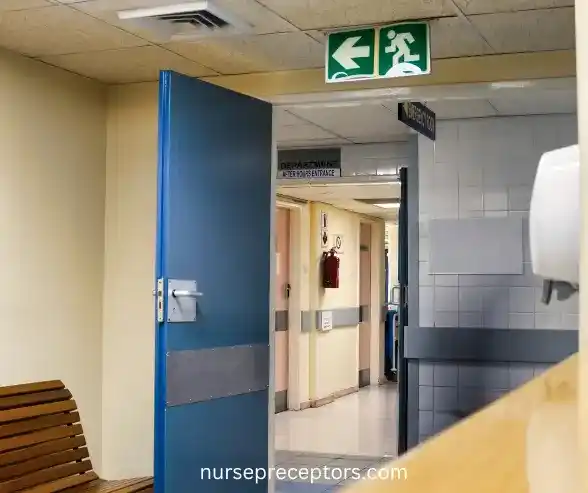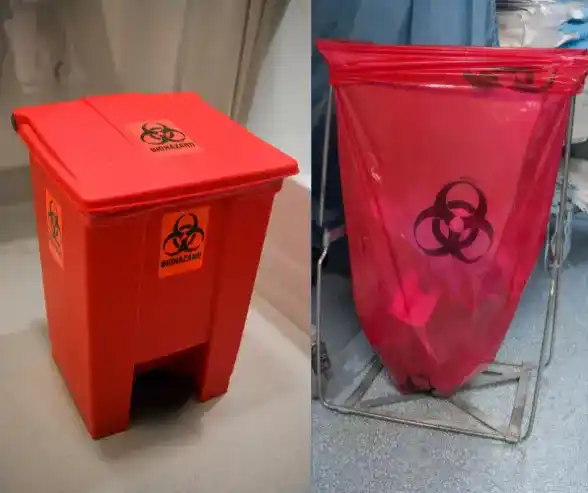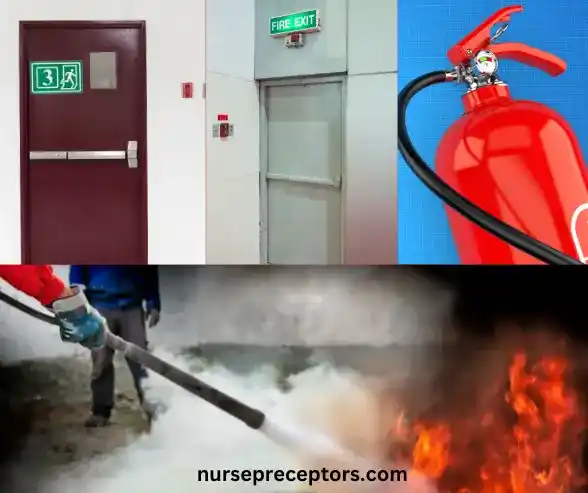Hospitals are complex ecosystems where healthcare delivery and environmental safety intersect, significantly impacting patient outcomes and overall public health. You can learn the full details about 5 Key Assessments for Environmental Safety in Hospitals in the USA from our Nurse Preceptors.
Assessing environmental safety in hospitals is a critical step in identifying potential hazards and implementing preventive measures. This involves conducting thorough inspections of the physical environment, including patient rooms, operating theaters, and common areas.
Key focal points during environmental safety assessments encompass verifying the availability of emergency exits and evacuation plans, ensuring the proper storage and labeling of hazardous substances, evaluating the efficacy of ventilation systems, and confirming the presence of requisite safety equipment such as first aid kits and fire extinguishers. Regular assessments and audits help hospitals maintain a safe and secure environment for patients and healthcare professionals.
Importance of Conducting Thorough Inspections
Environmental safety in hospitals involves a broad range of factors that contribute to the health and safety of everyone in the facility. These factors include the physical environment, chemical and biological hazards, and emergency preparedness. Effective environmental safety measures help prevent infections, reduce accidents, and ensure compliance with health regulations.
Environmental Assessment and General Preventive Measures
- Physical Environment
- Chemical Safety
- Biological Safety
- Emergency Preparedness
- Environmental Impact
1. Physical Environment
A. Infrastructure and Facility Maintenance

Building Integrity: Regular inspections are essential to detect structural damage, water leaks, and mold growth. These issues can compromise the building’s safety and contribute to health problems, such as respiratory issues. Maintaining the physical integrity of the hospital ensures a safe environment for patients and staff.
Lighting and Ventilation: Proper lighting and ventilation are critical for patient recovery and staff productivity. Adequate natural and artificial lighting helps create a comfortable atmosphere, while well-maintained HVAC systems improve air quality by ensuring proper ventilation.
Cleanliness: High standards of cleanliness in all areas, including floors, walls, and surfaces, are crucial for preventing the spread of infections. Regular cleaning schedules and protocols help maintain a hygienic environment.
Accessibility: Hospitals must be accessible to individuals with disabilities. This includes features like ramps, elevators, and clear signage to ensure compliance with regulations and provide a welcoming environment for all patients and visitors.
Ergonomics: Evaluating the design of workspaces helps prevent musculoskeletal disorders among staff, enhancing their well-being and productivity. Ergonomically designed workspaces reduce strain and improve efficiency.
B. Equipment Safety
Regular Maintenance: All medical and non-medical equipment should undergo regular maintenance and safety inspections to ensure proper functioning. This includes everything from MRI machines to wheelchairs.
Safety Checks: Routine checks of fire alarms, extinguishers, emergency lighting, and exits ensure they are in working order and meet safety standards. These measures are vital for responding effectively in emergencies.
Electrical Safety: Inspecting electrical outlets, cords, and appliances ensures they comply with safety standards, preventing electrical hazards that could endanger lives.
Read: Normal Vital Signs Decoded: What Your Body’s Signals Say About Your Well-Being
2. Chemical Safety
A. Hazardous Materials
Storage: Proper storage of chemicals, medications, and other hazardous materials prevents accidents and ensures safety. This includes secure cabinets and designated storage areas.
Labeling: All chemicals must be correctly labeled with hazard symbols and handling instructions to avoid misuse. Clear labeling helps staff identify and handle substances safely.
Handling Procedures: Staff should be well-trained in the safe handling and disposal of hazardous materials. Proper training minimizes exposure risks and ensures that materials are disposed of correctly.
Guidelines: Material Safety Data Sheet (MSDS) should be available in all the departments where hazardous materials are being used. Staff should have easy access to MSDS of every hazardous material.
B. Waste Management

Segregation: Proper segregation of biomedical, chemical, and general waste prevents cross-contamination and environmental pollution. Different types of waste should be disposed of in designated containers.
Disposal: Waste disposal methods must comply with environmental regulations to minimize the hospital’s ecological footprint. This involves collaborating with licensed waste disposal companies.
Spill Response: Adequate spill kits and response protocols should be in place to handle chemical spills safely and effectively. Prompt and proper response to spills protects staff and patients from exposure.
3. Biological Safety
A. Infection Control
Hand Hygiene: Adequate hand hygiene facilities and strict adherence to hygiene protocols are vital for preventing the spread of infections. Hand sanitizing stations and handwashing sinks should be readily available.
PPE Usage: Personal protective equipment (PPE) must be readily available and used correctly by staff and visitors to minimize exposure to infectious agents. Proper use of PPE is crucial for infection control.
Sterilization: Effective sterilization procedures for medical instruments and equipment are essential to ensure patient safety. Sterilization prevents the transmission of pathogens through medical devices.
Isolation Protocols: Clear protocols for isolating patients with infectious diseases help contain infections and protect other patients and staff. Isolation rooms and procedures are critical for managing contagious illnesses.
What is the Model of Conceptual Framework for a Generic BSN Program?
B. Indoor Air Quality
Ventilation Systems: Regular maintenance of HVAC systems and timely replacement of filters are necessary to maintain good indoor air quality. Clean air diminishes the likelihood of respiratory infections.
Airborne Pathogen Control: The use of HEPA filters and other measures can help control airborne pathogens, reducing the risk of respiratory infections. These filters capture harmful particles, improving air quality.
4. Emergency Preparedness

A. Emergency Plans
Evacuation Plans: Comprehensive evacuation plans and marked routes are essential for ensuring safety during emergencies. All employees should have a comprehensive understanding of the established evacuation protocols.
Drills and Training: Regular emergency drills and staff training help prepare everyone to respond effectively in case of an emergency. Training ensures that staff know how to act quickly and efficiently.
Emergency Supplies: Emergency supplies, such as first aid kits, flashlights, and food and water, should be readily available and accessible. These supplies are crucial for sustaining operations during a crisis.
What is nursing care delivery system? A guide for nurses.
B. Disaster Readiness
Natural Disasters: Hospitals must have preparedness plans for natural disasters like earthquakes, floods, and hurricanes to protect patients and staff. These plans should include protocols for safe evacuation and continuity of care.
Pandemic Response: Effective plans and protocols for handling pandemics and large-scale infectious disease outbreaks are crucial for maintaining healthcare services during crises. Lessons learned from recent pandemics should inform preparedness strategies.
5. Environmental Impact
A. Resource Conservation
Energy Efficiency: Implementing energy-efficient measures can reduce the hospital’s carbon footprint and operational costs. This entails the utilization of energy-efficient lighting and appliances.
Water Conservation: Water conservation practices help manage resources sustainably and reduce environmental impact. Simple measures like fixing leaks and using low-flow fixtures make a big difference.
Sustainable Practices: Using sustainable materials and practices supports environmental health and can enhance the hospital’s reputation. Green building practices and recycling programs are examples of sustainability initiatives.
B. Community Impact
Noise Pollution: Minimizing noise pollution can improve the hospital environment and its relationship with the surrounding community. Noise reduction strategies enhance the healing environment.
Community Health: Hospitals play a vital role in promoting community health by addressing environmental health concerns and engaging in public health initiatives. Community outreach and education programs can have a positive impact.
What are the common mistakes in nursing documentation? A comprehensive guide for nurses.
People at Risk for Safety Dysfunction in Hospitals

Maintaining a safe environment in hospitals is crucial for the well-being of patients, staff, and visitors. Hospitals can identify individuals at risk for safety dysfunction by conducting thorough environmental safety assessments and implementing targeted measures to protect these vulnerable groups.
Identifying individuals at risk for safety dysfunction requires understanding their unique vulnerabilities. Here are the key groups that are often at higher risk in a hospital setting:
1. Patients
A. Immune-Compromised Patients
Immune-compromised patients are at high risk due to their weakened immune systems, which makes them more susceptible to infections. This group includes patients undergoing chemotherapy, living with HIV/AIDS, or who have received organ transplants. Their vulnerability means that even minor infections can become serious health threats.
The environment must be meticulously controlled to minimize exposure to pathogens. This includes rigorous infection control measures such as frequent hand hygiene, proper use of personal protective equipment (PPE), and isolating these patients from potential sources of infection.
Enhanced cleaning protocols are necessary, utilizing hospital-grade disinfectants and increasing the frequency of cleaning, especially in high-touch areas. Additionally, HEPA filters can be used in ventilation systems to remove airborne pathogens and isolation rooms should be employed to further protect these patients from infectious agents.
B. Elderly Patients
Elderly patients face multiple risk factors due to age-related declines in both physical and immune functions. They are more prone to infections, falls, and other health complications. Falls are a significant concern as they can lead to severe injuries such as fractures.
Therefore, environmental safety measures must focus on fall prevention, including the installation of handrails, non-slip flooring, and fall alert systems. Proper lighting and clear, unobstructed pathways are crucial to reducing the risk of falls. In addition to physical safety, protecting elderly patients from infections is vital.
Vaccination against diseases like influenza and pneumonia should be prioritized, and strict infection control practices must be maintained to prevent hospital-acquired infections.
C. Pediatric Patients
Children are particularly vulnerable due to their developing immune systems and different physiological responses compared to adults. They are more susceptible to infections and environmental hazards.
Ensuring their safety involves secure storage of hazardous materials such as cleaning agents and medications, which should be kept out of children’s reach. Medical equipment and devices used should be age-appropriate to avoid injuries and ensure accurate treatment.
Play areas must be maintained with high hygiene standards, regularly disinfecting toys and surfaces to prevent the spread of infections. Additionally, these areas should be designed to be free from sharp edges and other hazards to provide a safe environment for young patients.
What is the mechanism of pressure ulcer formation? Read the complete article.
D. Patients with Chronic Conditions
Patients with chronic conditions such as diabetes, respiratory diseases, and heart conditions face unique environmental risks that require specific controls. For example, individuals with respiratory conditions are particularly sensitive to air quality.
Hospitals must ensure good indoor air quality by using air purifiers and maintaining proper ventilation systems. These patients may also require specialized care environments equipped with necessary medical devices and tailored protocols to manage their conditions effectively.
Medication safety is another critical aspect, as chronic condition patients often take multiple medications. Proper labeling, medication reconciliation processes, and patient education are essential to ensure safe medication handling and adherence, preventing adverse drug interactions and errors.
2. Hospital Staff
A. Healthcare Workers (Doctors, Nurses, Technicians)
Healthcare workers are at the frontline of patient care and are exposed to various risks, including infectious diseases, chemical hazards, and physical strain. The nature of their work involves long hours and repetitive tasks, which can lead to physical strain and fatigue.
To mitigate these risks, healthcare workers must have access to adequate personal protective equipment (PPE) to protect against infections and chemical exposures. Workspaces should be designed ergonomically to reduce physical strain, incorporating adjustable chairs, work surfaces at appropriate heights, and tools designed to minimize repetitive movements.
Regular breaks and mental health support are also crucial to help manage stress and prevent burnout, ensuring that healthcare workers can provide the best possible care to patients.
B. Housekeeping and Maintenance Staff
Housekeeping and maintenance staff play a critical role in maintaining a clean and safe hospital environment but face significant risks themselves. They are frequently exposed to cleaning chemicals, which can pose health hazards if not handled properly. Physical strain from tasks such as lifting heavy objects and repetitive movements can lead to injuries.
Comprehensive training on the safe use and storage of chemicals is essential to protect these workers. Ergonomic tools and equipment. Strict waste management protocols must be enforced to ensure the safe handling of biomedical and hazardous waste, reducing the risk of injuries and infections.
C. Administrative and Support Staff
Administrative and support staff, while less exposed to direct clinical hazards, still face risks related to poor indoor air quality and ergonomic strain. Ensuring a safe work environment for these staff members involves maintaining proper ventilation in office areas, which helps maintain good air quality and reduces the risk of respiratory issues.
Ergonomic workstation design is critical to prevent repetitive strain injuries, providing adjustable chairs, desks, and computer monitors. Encouraging regular breaks is important to reduce the risk of physical and mental fatigue, promoting overall well-being and productivity among administrative staff.
3. Visitors
A. Family Members and Caregivers
Family members and caregivers who visit patients can be exposed to hospital-acquired infections and experience significant stress from caregiving duties. To protect visitors, hospitals should educate them on proper hand hygiene and other infection control practices, providing clear instructions and signage.
Ensuring that visitors can easily navigate the hospital and understand safety protocols, including emergency exits and handwashing stations, is essential. Offering support services such as counseling, rest areas, and information on managing caregiving duties can help reduce stress and promote the well-being of visitors.
What is the fundamental concept behind definition of nursing?
4. Special Populations
A. People with Disabilities
Individuals with disabilities often encounter difficulties in navigating the hospital environment due to mobility challenges, sensory impairments, and increased dependency on staff and equipment. To ensure their safety and comfort, hospitals must prioritize accessibility features.
This includes installing ramps and elevators, ensuring doorways and hallways are wide enough for wheelchairs, and providing clear signage that is easy to understand. Additionally, specialized equipment like communication devices for patients with speech impairments and adjustable beds for those with mobility issues can significantly enhance their hospital experience and independence.
It’s also important for staff to receive training on how to assist patients with disabilities effectively and respectfully.
B. Language Barrier Individuals
Language barrier individuals often struggle to understand safety instructions, medical procedures, and care plans due to language barriers. This can lead to misunderstandings and non-compliance with medical advice, increasing the risk of adverse outcomes.
Hospitals can mitigate these risks by providing multilingual signage, offering access to professional translation services, and employing bilingual staff when possible. Additionally, culturally competent care is crucial; staff should be trained to understand and respect cultural differences, ensuring that care plans are sensitive to the patient’s linguistic and cultural needs.
Effective communication can significantly enhance patient safety and satisfaction, making language barrier individuals feel more comfortable and understood.
C. Patients with Mental Health Conditions
Patients with mental health conditions, such as depression, anxiety, schizophrenia, and bipolar disorder, often have unique safety needs in a hospital setting. Individuals within these conditions may be at an elevated risk of engaging in self-harming behaviors or encountering a mental health emergency.
Ensuring their safety requires specialized care environments that are calming and secure. Staff must be trained in mental health first aid and crisis intervention techniques to manage and de-escalate situations effectively.
It’s also essential to provide regular mental health assessments and offer access to psychiatric care, counseling, and support groups within the hospital to address their needs comprehensively.
D. Pregnant Women
Pregnant women have specific medical and safety needs, as both their health and the health of their unborn child are at stake. They are particularly vulnerable to infections and environmental hazards such as exposure to harmful chemicals.
Ensuring their safety involves maintaining a clean environment free from pathogens, providing access to prenatal care, and offering appropriate nutritional support. Emergency protocols should be in place for managing obstetric emergencies, and staff should be trained in handling pregnancy-related complications.
Safe and comfortable facilities for labor, delivery, and postnatal care are essential to protect the well-being of both mother and child.
E. Patients with Severe Allergies
Patients with severe allergies, including food, medication, and environmental allergies, are at high risk for adverse reactions that can be life-threatening. Hospitals must implement strict protocols to prevent exposure to allergens, which include detailed screening of patient allergies upon admission, clear labeling of patient charts and wristbands, and rigorous cross-checking of medications and food served.
Emergency response plans should be in place, and staff must be trained to recognize and respond to allergic reactions promptly. Regular monitoring and creating an allergen-safe environment are critical to preventing accidental exposure.
How to Conduct the Environmental Safety Assessment?
- Form an Assessment Team: Include representatives from various departments such as facility management, nursing, housekeeping, and infection control. The presence of a diverse team ensures a comprehensive evaluation of environmental safety.
- Use Checklists and Tools: Utilize standardized checklists and tools to ensure a systematic and thorough evaluation. Checklists help cover all necessary areas.
- Identify Risks: Use patient and staff records to identify individuals with specific vulnerabilities. Cross-reference these records with environmental safety assessments to pinpoint areas of concern.
- Collect Data: Conduct site visits, interviews, incident reports, and document reviews to gather relevant data. Accurate data collection is key to identifying issues.
- Identify Issues: Document any hazards, non-compliance, or areas needing improvement. Clear documentation helps prioritize actions.
- Develop Action Plans: Create actionable plans to address identified issues, with timelines and responsible parties. Action plans ensure accountability and progress.
- Monitor Progress: Regularly review and update the assessment to ensure ongoing compliance and improvement. Continuous monitoring helps maintain high safety standards.
- Feedback: Gather feedback from at-risk individuals to make necessary adjustments.
Conclusion
Ensuring environmental safety in hospitals is an ongoing process that requires diligent assessment, adherence to protocols, and continuous improvement. By prioritizing environmental safety, hospitals can create a healthier, safer, and more efficient environment for patients, staff, and visitors.
Regular assessments, combined with a proactive approach to addressing identified issues, are essential for maintaining high standards of safety and care in healthcare facilities.
A safe hospital environment not only protects those within its walls but also contributes to the overall health and well-being of the community it serves.
By embracing comprehensive environmental safety practices, hospitals can fulfill their mission of providing quality care while safeguarding the health of all who enter their doors.
References:
- Hospital Risk Assessment: Environmental Health and Safety Compliance, and Physical Security Standards. (n.d.). Strategic Management Services, LLC. https://www.compliance.com/resources/hospital-risk-assessment-environmental-health-and-safety-compliance-and-physical-security-standards/
- CDC. (2019, August 14). Environmental Assessment | Model | Workplace Health Promotion | CDC. Www.cdc.gov. https://www.cdc.gov/workplacehealthpromotion/model/assessment/environmental.html
- Environment of Care Risk Assessment, 4th edition. (n.d.). Joint Commission Resources. https://store.jcrinc.com/environment-of-care-risk-assessment-4th-edition-/
- Patient safety assessment manual. (n.d.). https://applications.emro.who.int/dsaf/emropub_2011_1243.pdf
- Environmental Health and Safety Management System. (2011). Nih.gov; National Academies Press (US). https://www.ncbi.nlm.nih.gov/books/NBK55873/